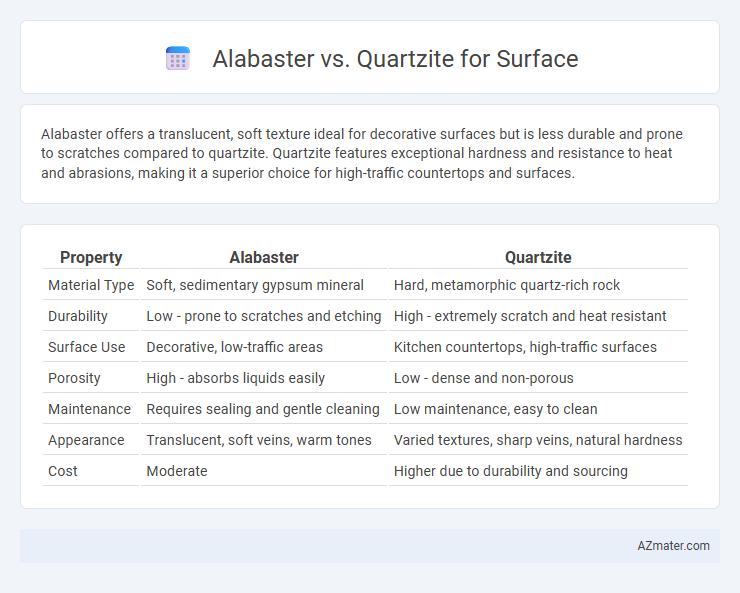Alabaster offers a translucent, soft texture ideal for decorative surfaces but is less durable and prone to scratches compared to quartzite. Quartzite features exceptional hardness and resistance to heat and abrasions, making it a superior choice for high-traffic countertops and surfaces.
Table of Comparison
| Property | Alabaster | Quartzite |
|---|---|---|
| Material Type | Soft, sedimentary gypsum mineral | Hard, metamorphic quartz-rich rock |
| Durability | Low - prone to scratches and etching | High - extremely scratch and heat resistant |
| Surface Use | Decorative, low-traffic areas | Kitchen countertops, high-traffic surfaces |
| Porosity | High - absorbs liquids easily | Low - dense and non-porous |
| Maintenance | Requires sealing and gentle cleaning | Low maintenance, easy to clean |
| Appearance | Translucent, soft veins, warm tones | Varied textures, sharp veins, natural hardness |
| Cost | Moderate | Higher due to durability and sourcing |
Understanding Alabaster and Quartzite: Key Differences
Alabaster is a soft, translucent mineral primarily composed of gypsum or calcite, known for its smooth texture and warm, creamy appearance, making it ideal for decorative surfaces. Quartzite, a hard metamorphic rock formed from sandstone, offers exceptional durability and resistance to scratching and heat, suited for high-traffic countertops and flooring. Key differences lie in their hardness (Alabaster rating 2 on Mohs scale, Quartzite 7+), porosity, and maintenance requirements, influencing their practical applications and longevity in surface use.
Appearance and Aesthetic Appeal
Alabaster offers a soft, translucent appearance with delicate veining that creates an elegant and warm ambiance, often favored for decorative surfaces and artistic applications. Quartzite provides a more robust and varied aesthetic, featuring natural stone patterns with subtle shimmer and a range of colors from white to gray and blue hues, ideal for durable countertops with a sophisticated look. The choice between alabaster and quartzite depends on the desired visual impact and functional demand, with alabaster emphasizing refined beauty and quartzite showcasing natural stone resilience.
Durability and Strength Comparison
Quartzite is significantly more durable and harder than alabaster, making it ideal for high-traffic surfaces like kitchen countertops and flooring. Alabaster, being a softer, more porous stone with a Mohs hardness of around 2, is more prone to scratches, dents, and staining, thus best suited for decorative or low-impact applications. Quartzite typically rates between 7 and 8 on the Mohs hardness scale, offering superior resistance to heat, chemicals, and abrasion, ensuring long-lasting surface performance.
Maintenance Requirements
Alabaster surfaces demand careful maintenance due to their softness and susceptibility to scratching and staining, requiring regular sealing and gentle cleaning methods. Quartzite offers superior durability and low maintenance, resisting scratches, heat, and stains without needing frequent sealing. Choosing quartzite minimizes upkeep time and costs, making it ideal for high-traffic areas with heavy use.
Suitability for Different Applications
Alabaster offers a soft, translucent surface ideal for decorative applications such as wall panels and light fixtures, but its lower hardness and porosity limit its use on high-traffic or heavy-duty countertops. Quartzite, known for its exceptional durability, hardness (around 7 on the Mohs scale), and resistance to heat and scratches, excels as a countertop material in kitchens and bathrooms where strong wear resistance is essential. Selecting between alabaster and quartzite hinges on balancing aesthetic preferences with functional requirements, favoring quartzite for rigorous daily use and alabaster for artistic, low-impact installations.
Cost Considerations and Value
Alabaster surfaces typically cost less than quartzite, making it a budget-friendly option for decorative or light-use areas, but its softness and susceptibility to scratches reduce long-term durability. Quartzite, although higher priced, offers superior hardness and resistance to heat and stains, providing excellent value in high-traffic or kitchen surfaces due to its longevity and minimal maintenance. Evaluating cost considerations involves balancing initial investment with durability and lifespan, where quartzite's premium cost often translates into greater value over time.
Resistance to Stains and Scratches
Quartzite offers superior resistance to stains and scratches compared to alabaster, as it is a harder and more durable natural stone. Alabaster, being softer and more porous, is more susceptible to etching, staining, and surface damage from acidic substances and sharp objects. Quartzite's dense composition and natural silica content make it ideal for high-traffic surfaces requiring long-lasting durability and minimal maintenance.
Installation Process and Challenges
Alabaster surfaces require careful handling during installation due to their softness and vulnerability to scratching, often necessitating specialized cutting tools and gentle adhesive application to prevent damage. Quartzite, being an extremely hard and dense natural stone, mandates the use of diamond blades and precision equipment for cutting and shaping, making the installation process more labor-intensive and time-consuming. Both materials demand professional expertise, but quartzite's durability offers greater long-term resistance to chipping and heat, while alabaster requires more frequent maintenance and protective measures post-installation.
Environmental Impact and Sustainability
Alabaster, a soft, porous mineral primarily composed of gypsum, has a lower environmental impact due to its ease of quarrying and minimal processing requirements compared to quartzite, a harder, metamorphic rock demanding intensive energy for extraction and fabrication. Quartzite offers greater durability and longevity, reducing the frequency of replacement and thus contributing to long-term sustainability despite its higher initial environmental footprint. Sourcing local materials and employing sustainable quarrying practices significantly influence the overall eco-friendliness of both alabaster and quartzite surfaces.
Which Surface is Best for Your Needs?
Alabaster offers a unique, translucent appearance ideal for decorative surfaces but is relatively soft and prone to scratching, making it less suitable for high-traffic areas. Quartzite, known for its exceptional durability and resistance to heat and scratches, is a superior choice for countertops and heavy-use surfaces requiring longevity. Selecting between alabaster and quartzite depends on balancing aesthetic preference with practical durability needs, with quartzite often favored for functional, long-lasting applications.

Infographic: Alabaster vs Quartzite for Surface
 azmater.com
azmater.com